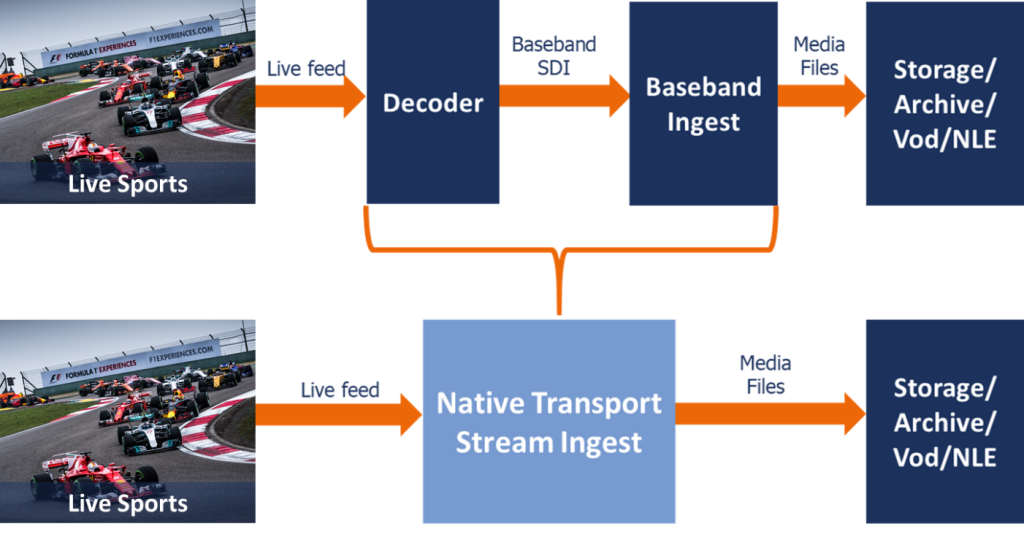BBright Live Content Ingest solution – Customer Use-cases
Blog & white papers
20 April 2020
Live Ingest is a key element of broadcaster’s workflows, which provides content for NLE [Non Linear Editing], VOD [Video On Demand] platforms and archiving. While the established approach is based on baseband/SDI ingest (combining decoders and baseband/SDI recorders), there is today more and more benefits to transition to native compressed stream ingest.
Benefits of TS/compressed stream-based Ingest
Live content ingest is usually processed in two steps:
- Live contribution feed decode
- Baseband (SDI) content ingest and transcode into a file.
Once the content is ingested and available as a file, it can be transferred to VOD platforms or NLE for edition. Baseband ingest is straightforward and easy to deploy, as it ensures a good interoperability level by using original baseband video signal. By the way, with the move to pure IP workflows and the emergence of new media formats (HDR, new audio Codecs…), native Transport Stream ingest delivers multiple advantages:
1- Move to pure IP infrastructures
Native Transport Stream ingest makes the use of complex SDI matrixes & routing unnecessary.
2- Keep the Quality untouched
Native Transport Stream ingest potentially removes one transcode step in the workflow. Knowing that each video or audio transcode operation will impact the content quality, maintaining the original contribution codec preserves the media asset quality.
More critical than all, with the emergence of object-based audio, the traditional decode/re-encode approach does not work anymore. Since decoding is related to a special rendering mode, it’s no more feasible to decode object-based audio then re-encode the audio content for final distribution. Keeping the native compressed format becomes mandatory for such a use-case with object-based audio.
3- Preserve the signalization and essential metadata
A proper distribution is becoming more dependent on metadata for live content: SCTE-35 for Ads insertion, Closed Captions and DVB subtitles, HDR metadata… Keeping the native format of the contribution for content ingest and record processing is the best way to preserve all metadata without any alterations. It’s even more prevalent with the use of additional metadata embedded on video elementary streams: such as dynamic HDR metadata, live Captions…
4- Simplify the workflow
Let’s keep the workflow simple; this is the best way to save time and money. Native Transport Stream Ingest will reduce the number of products required (in a nutshell: decoders/recorders and SDI routing are just replaced by TS ingest stations and TSoIP routing).
5- Be resolution agnostic and future proof
Compressed ingest will simplify the move to the highest content quality. The shift from HD to Ultra HD is now becoming more a reality. Even 8K TSoIP ingest can be processed without updating the technical infrastructure.
BBright UHD-TSI is the perfect solution to deploy IP-based / TS Ingest:
- Natively “UHD-ready”
- Ingest Scheduler for 24-7 automated operation
- Audio and Video Monitoring, including HDR metadata
- Transcode capabilities (for video proxy files or specific media format exportation)
BBright UHD-TSI has already been deployed in multiple customer use-cases, let’s introduce some of them.
Use Case #1: Time shift replay for Sport events
During major Worldwide Soccer event, BBright UHD-TSI ingest solution has been deployed both in North America and Latin America to provide ingest & storage functions of all soccer games, then push them for playout a few hours later to align with local time zones.
Use Case #2: generate content for VOD platforms
BBright UHD-TSI also offers internal SD/HD transcoding capabilities to generate content preview files or export to some specific video master file formats. Such a feature facilitates the integration of BBright UHD-TSI to simultaneously record high quality media content for VOD transcoders and also to generate lower quality preview files for VOD OTT portals.
VOD service providers do not need any more to worry about contribution formats and audio/metadata flavors: content is recorded in its native format and still embeds all information and metadata for HDR, Audio and other services such as Closed Captions and subtitles.



